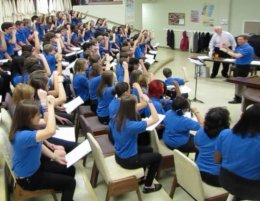
Teaching Middle School Choir
 Armed with a master’s degree in music, a wonderful student teaching experience, and lots of excitement about beginning my teaching career, I’ll never forget the incredible dark cloud that seemed to descend over my classroom during my first year of teaching at a middle school when I would ask my students to pull out their sight-singing books. I can still hear the moans and sighs like it was yesterday.
Armed with a master’s degree in music, a wonderful student teaching experience, and lots of excitement about beginning my teaching career, I’ll never forget the incredible dark cloud that seemed to descend over my classroom during my first year of teaching at a middle school when I would ask my students to pull out their sight-singing books. I can still hear the moans and sighs like it was yesterday.
Sight-singing was a chore – a necessary evil of sorts.
What was the problem? I had purchased the best sight-singing books. Shouldn’t that have done the trick? Apparently not, as I was completely unable to get my 300 inexperienced middle school students to be successful at sight-singing and, most importantly, to enjoy the process of learning it.
Over time, I determined many reasons for my lack of success at teaching this important skill and none of those reasons had anything to do with my students’ intellectual abilities or the types of students I was teaching. It had to do with me. I simply didn’t know how to instill the skill sets required for them to successfully sight-sing, and I didn’t respect how incredibly difficult this skill is for this special young age group.
After six years of being immersed in academia surrounded by highly trained musicians, most of whom had never taught middle school, I had lost touch with some really important ideas:
- Reading music is very similar to learning a foreign language.
- At least 95 percent of my students had no private instrument or voice lessons in their background. Whatever they learned about sight-singing was going to have to come from me. I couldn’t rely on having Peggy Piano in the back row who had taken piano lessons for nine of her 11 years to lead everyone else into the promised land.
- Success and fun are the magic potion for this age group. I had to figure out how to instill the skills in my students in a fun way. So, over time, I developed a four-part philosophy of teaching students to sight-sing.
Part 1: It Can’t Feel Like Work
I felt sure that the Kodály hand signs would help my students improve, but they didn’t seem to like using the signs. I soon realized that this age group loves to compete against the teacher so I made up a game that I called “Forbidden Pattern, ” where the students played against me.
Here are some basic procedures of the game:
- Everyone must use the Kodály Hand Signs while they sing.
- I sing and sign a three-note “forbidden pattern” followed by a rest, and they immediately have to sing and sign it back to me. Then I’ll move on and sing different variations of that pattern, which the students have to sing back to me. This repeats over and over again until I finally repeat the “forbidden pattern” of the day.
- Each day, there is a different “forbidden pattern” that the students aren’t allowed to sing.
- If one student sings the forbidden pattern, I get a point. If no one sings the pattern, they get a point.
- Whoever scores three points first wins the game. I keep score daily. I make the score public to all of my classes so they will begin a friendly competition with the other classes in addition to competing with me.
Classroom Management Guidelines:
Students are likely to get very excited during the game, and that is a good thing. However, you need some rules in place to keep the game fun and manageable!
First, students aren’t allowed to warn each other that the forbidden pattern has been sung. You should only award the students a point if they’ve been absolutely silent and still when the forbidden pattern is sung.
Second, have fun with the game! Use what I call the distraction technique. In the middle of the game, talk about your cat or what you did over the weekend. Then, sing the forbidden pattern. Soon, they will realize what you are up to! It helps them focus even more because they think you are being sneaky (and you are!) because you want to win! The possibilities are endless, and the relationship you will build with them when you let loose with playful competitiveness in this way will help you bond with your students as you teach them!
YOU MIGHT ALSO LIKE



Share this Post
Related posts
Eisenhower Middle School Choir
General Admission Formed in 2011, General Admission is Eisenhower s 6th grade beginning chorus. This group is not auditioned…
Read MoreMiddle School Choir songs
Dear 6th, 7th, and 8th Grade KTEC Choir Parents and Students, I am so happy to be part of the KTEC family again! It is such…
Read More










